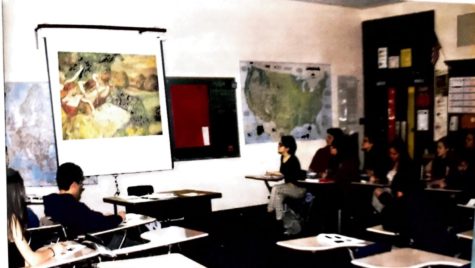Your donation will support the student journalists of the Evanstonian. We are planning a big trip to the Journalism Educators Association conference in Philadelphia in November 2023, and any support will go towards making that trip a reality. Contributions will appear as a charge from SNOSite. Donations are NOT tax-deductible.
Detracking begins to take effect
January 28, 2022
The detracking initiative was promising: early statistics were favorable and have only improved since. In 2017, Bavis reported that the class of 2015, the first freshman class to take Pathway to Honors classes, took the most AP classes out of any graduating class prior to them. Furthermore, this same group of students held the largest ACT score average in comparison with every previous year. Today, the ETHS website reads, “In recent years, more AP classes have been added, and the number of students of all races taking AP classes has grown by over 300%.”
However, as more students from diverse backgrounds gain access to advanced classes, ETHS continuously struggles to make these spaces, ones that have traditionally been dominated by white students, welcoming and safe for everyone. Burns speaks to one group he identifies with that has been historically discriminated against in classroom settings.
“I think teachers expect to have behavioral issues with young, Black male students in particular, so they over-police, in a sense. I remember growing up where everybody [would be] talking in the class, but with some teachers, I would get singled out for my behavior, and a white student or some other student wouldn’t,” Burns recalls. “I think, because our society over-criminalizes young Black men in particular, that also finds its way into the classroom. In the same way that we’re over-policed outside, we’re over-policed inside. There’s too much time spent trying to modify behavior instead of teaching Black, male students.”
Although ETHS looked much different when Burns was a student 18 years ago, the disproportionate student penalization on the basis of race he speaks of has seemingly remained intact. Current students have made similar observations, which limits the capability for success in a class, regardless of whether it’s tracked or not.
“What I’ve noticed is [that] the Black kids are more likely to even be sent to the dean’s office, so that’s the first step of the pyramid of the discipline system: the teachers sending the kids to the dean. Who are the [kids that] teachers [are] claiming are disrespectful? Who are [the kids that] the teachers [are] claiming are disruptive? Who are the kids that teachers are saying are problematic? These are kids of color,” current junior and ETHS Students Organized Against Racism (SOAR) member Phoenix Perlow-Anderson notes. “A lot of the time, there’s more to the story than just the kid being disrespectful.”
For over a decade, ETHS has persistently worked to minimize the opportunity gap through policy change, but the school has yet to make meaningful strides in terms of fixing the discrimination that exists within classroom culture.
“[Black students] have to be twice as good as [white students] in order to be recognized, and I’ve felt like that throughout my whole time at ETHS,” Perlow-Anderson shares. “I have to speak more eloquently, [and] I have to do better in my work just to have that recognition of my excellence. I have to try two times harder than the white students in my class.”

In 2011, nine students founded Team Access and Success in Advanced Placement (Team ASAP) as a way to seek out equity in AP and higher level classes. Since then, Team ASAP has only expanded and continues to offer various resources to students who are enrolled, or plan on enrolling, in AP classes.
“The purpose of Team ASAP is to break down the barrier of who is able to be an AP student versus who isn’t able. We discuss aspects such as learning disabilities and race and how those play into the divide in AP classrooms,” junior and Team ASAP board member Kyla Wellington explains. “Right now, the student leaders, including myself, are focusing on different approaches of how to motivate students of all backgrounds to feel welcomed to at least try out one AP class that ETHS provides.”
From restructuring curriculums to forming student clubs, ETHS has relentlessly reenvisioned the ways in which it considers equity and inclusion. Despite the significant accomplishments of the school over the past 12 years, there is still immense improvement that must be made, and that comes with recognition and accountability.
“I think historically, one of the greatest challenges is that an apology is to blame somebody else. It’s always easy for the high school to blame the middle school, for the middle school to blame the elementary school, for the elementary school to blame the parents. Ultimately, an effort to shift the responsibility away is an excuse not to solve the problem,” Biss expresses. “It’s really exciting to live in a time when educators, as well as administrators and community members, are starting to say, ‘You know what? We don’t get to just be sad about this and say it’s somebody else’s fault. We’re going to take ownership and do our best to address this.’”
This concept of accountability is one that many activists have centered in their work. According to Bobby Burns’ mother, Martha Burns, a previous school board member who advocated for equity in the school, accepting responsibility is vital to the growth of ETHS. As the oppurtunity gap persists, as students of color remain feeling unwelcome in their own school, and as teachers continue to send the same students to the dean’s office, it is crucial to acknowledge the lingering segregation and discrimination that strongly permeates the building in order to truly eliminate it for good.
Bobby Burns remembers his mother’s attitude surrounding ETHS, which still holds up today.
“What [my mother] was always trying to get Evanston to do better is to, as an institution, accept its own [responsibility and] to take accountability for the achievement gap.”
Both Burns and his mother believe that any influential person or organization must accept the role they play in prolonging discrimination.
“In the same way that [what] any good coach or leader would do is to say, ‘Even if some of this is outside of my control, as the leader of educating students in this district, we’re going to take all of the blame. We’re going to say it’s on us, as an institution, to make sure students are educated. Every student is educated no matter what neighborhood they live in, what their household income is and what supplemental enrichment programs they have access to outside of school. Regardless of all of that, we’re going to take accountability for students failing in our school system,’” Burns describes. “She always wanted to push Evanston to do that, and I think [Evanston schools are] doing it now or certainly moving closer to it.”
